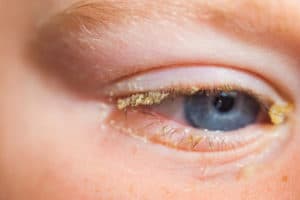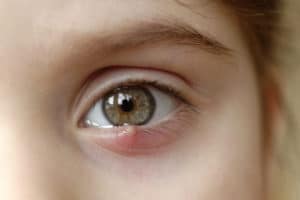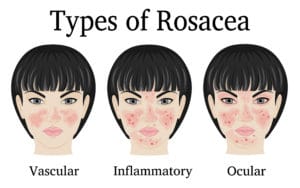What is Ocular Surface Disease?
 Ocular surface disease describes any number of problems that can occur on the surface, or cornea, of the eye. Most ocular surface diseases can start out as simply irritating but can increase in severity over time. The most common eye problems affiliated with ocular surface disease are infections, oil, inflammation, and dryness.
Ocular surface disease describes any number of problems that can occur on the surface, or cornea, of the eye. Most ocular surface diseases can start out as simply irritating but can increase in severity over time. The most common eye problems affiliated with ocular surface disease are infections, oil, inflammation, and dryness.
Eye hygiene is a difficult topic to address. While we take many daily actions to ensure our bodies are clean and healthy like bathing, brushing our teeth, and washing our hair, our eyes are quite a bit more difficult to clean. Soap stings our eyes, and it is often uncomfortable to let water touch them. Because they are so difficult to clean, it is no surprise that our eyes become easily infected, inflamed, or oily. The eye care community is actively working to improve health and make our eyes easier to clean by teaching patients to clean eyelids and lashes comfortably.
Many patients visit Dr. Vital at Houston Eye Associates suffering from symptoms such as burning or crusting eyes, swelling, irritation, and dryness – all categorized as an ocular surface disease. These are mainly caused by oil, inflammation, and infection.
What is an Eye Infection?
 Dentists often recommend daily brushing and flossing, which prevents the buildup of bacteria in the mouth that causes infections, bad breath, and tooth decay. The ocular surface is similar to our mouths – both consist of mucous membranes with tendencies of accumulating bacteria due to the moisture. Additionally, our eyelash follicles are also susceptible to a common skin mite called Demodex.
Dentists often recommend daily brushing and flossing, which prevents the buildup of bacteria in the mouth that causes infections, bad breath, and tooth decay. The ocular surface is similar to our mouths – both consist of mucous membranes with tendencies of accumulating bacteria due to the moisture. Additionally, our eyelash follicles are also susceptible to a common skin mite called Demodex.
Everyone has bacteria on their eyelids, and studies show that most people even have Demodex! These can cause oil gland problems like inflammation and redness, although everyone has slightly different reactions to the microbes – some worse than others. One of the easiest and most effective ways to keep these microbes at bay is lid scrubs.
What is an Eye Oil Gland Infection?
 The oil glands of our eyelid margins can be compared to a case of acne. Although bacteria, oil, and inflammation cause acne, acne is not referred to as a facial infection. It is also unrealistic to expect acne to clear up in one day or week, as much as we may want it to. Clearing up acne takes time and attention to the problem. This is similar to the oil glands of the eyelid margins, called the meibomian glands. The oils all eyelids secrete should be the consistency of olive oil, and the body uses these oils to coat the eye’s surface, prevent the break up of the tear film, and reduce tear evaporation. When bacteria and inflammation come into the mix these oils can become thick and it becomes more difficult for them to squeeze out of our eyelids, causing irritation.
The oil glands of our eyelid margins can be compared to a case of acne. Although bacteria, oil, and inflammation cause acne, acne is not referred to as a facial infection. It is also unrealistic to expect acne to clear up in one day or week, as much as we may want it to. Clearing up acne takes time and attention to the problem. This is similar to the oil glands of the eyelid margins, called the meibomian glands. The oils all eyelids secrete should be the consistency of olive oil, and the body uses these oils to coat the eye’s surface, prevent the break up of the tear film, and reduce tear evaporation. When bacteria and inflammation come into the mix these oils can become thick and it becomes more difficult for them to squeeze out of our eyelids, causing irritation.
These now thick oils can clog the glands, causing a chalazion (stye). This is referred to as meibomitis or meibomian gland dysfunction. The chalazia involve the buildup of bacteria and oil, but are not actual infections. In fact, they are more like large pimples that can lead to “acne” of the eyelids. Meibomian Gland Dysfunction promotes bacterial growth and inflammation of the eyes.
Several methods used for treating meibomitis include thinning the oils using heat, expressing the oils from the eyelids, and reducing inflammation in the eyelids.
What is Eye Inflammation? (Redness and Swelling)
 Our immune systems generally act as the first defense our bodies use against infections and sickness. In some cases, our immune systems can get confused and become overactive, causing damage to our body’s tissues. This is often seen in cases of asthma or eczema.
Our immune systems generally act as the first defense our bodies use against infections and sickness. In some cases, our immune systems can get confused and become overactive, causing damage to our body’s tissues. This is often seen in cases of asthma or eczema.
The same sensation can occur in our eyes. Overactive inflammation of the eyelids and the whites of the eyes (conjunctiva) can cause our eyes to swell and to become red and itchy. In some cases, this can cause the growth of blood vessels into the cornea. This can cause scarring and blurred vision. This inflammation can come and go, often occurring in reaction to issues with infection, oil, and dry eyes.
What are Dry Eyes?
 Dry eyes are commonly caused by the above issues – eye infections, oil, and inflammation. Because of this, Dr. Vital frequently finds that a patient’s dry eye is not caused by not having enough tears, but rather is a dry eye sensation caused by another underlying eye condition. Because of this, treating issues with infection, oil glands, or inflammation generally lead to substantial improvement in symptoms of dry eye.
Dry eyes are commonly caused by the above issues – eye infections, oil, and inflammation. Because of this, Dr. Vital frequently finds that a patient’s dry eye is not caused by not having enough tears, but rather is a dry eye sensation caused by another underlying eye condition. Because of this, treating issues with infection, oil glands, or inflammation generally lead to substantial improvement in symptoms of dry eye.
Other common causes of dry eye are incomplete blinking or sleeping with eyes partially open, which are classified as evaporative dry eye problems. Tear deficiency (not having enough liquid tears) is rarer.
How Do You Treat Dry Eyes?
What are the Common Ocular Surface Disease States?
There are many ‘states’ of ocular surface disease, which are caused by varying combinations of the above underlying causes. Often, symptoms of these states are extremely similar to one another and therefore they are easily confused. Many of these conditions are chronic and are therefore managed with treatment as opposed to being cured permanently.
Bacterial blepharitis and conjunctivitis (infection):
Infection of the eyelid margin and whites of the eyes, characterized by redness, swelling, itching, tearing, burning, and crusting.
Viral conjunctivitis (infection):
Commonly referred to as “pink eye“. This condition is caused by Adenovirus and can cause corneal spot scars. Symptoms include severe redness, swelling of the eyes, itching, tearing, burning, and blurred vision.
Staphylococcal hypersensitivity (infection and inflammation):
Caused by a hyperactive immune response to the exotoxins of Staphylococcal bacteria on eyelid margins and lashes. This can lead to scarring of the cornea. Symptoms include recurring redness, swelling, pain, and blurred vision.
Demodex blepharitis (infection and inflammation):
This is an infection of the eyelash follicles, which is caused by the Demodex mite. Symptoms of Demodex blepharitis include red eyes, dry eyes, crusting, and itching.
Meibomitis (oil and inflammation):
Inflammation of meibomian glands caused by thickening of eyelid oils. Common symptoms include redness, dryness., blurred or fluctuating vision, recurring chalazia, pain, and swelling.
Ocular rosacea (infection, oil, and inflammation):
This is an inflammatory response, caused by Demodex, bacteria, and oils impacting eyelids, whites of the eyes, cheeks, nose, and forehead. This can cause dilated vessels and occasional thickening of the skin of the nose (rhinophyma). Symptoms of Ocular rosacea include redness, flushing, dry eyes, burning, pain, blurry vision, and fluctuating vision.
Allergic Conjunctivitis (inflammation):
This is an immune response that leads to the inflammation of the lids and whites of the eyes. Allergic conjunctivitis is often caused by allergens in the surrounding environment or as a side-effect caused by medications. Symptoms include itching, redness, dy eyes, and tearing.
Dry eye syndrome (infection, oil, inflammation, and true dryness):
The sensation or actual dryness of the eye’s surface. Symptoms of dry eye syndrome include dryness, burning, pain, blurry vision, and fluctuating vision.
How is Ocular Surface Disease Treated?
With each state of ocular surface disease, the most basic treatment regimen is the daily cleaning of the eyelid margins once or twice a day depending on how active the disease is. At Houston Eye Associates, Dr. Vital will most commonly recommend the use of Cetaphil Gentle Skin Cleanser for All Skin Types. You can learn more about the use of Cetaphil on this page. Other methods of treatment for an ocular surface disease are dependent on the underlying cause of the problems. Below you will find a list of common treatments used.
What are Common Treatments for Eye Infections
Treatments for Bacterial Eye Infections:
- Antiseptics: Avenova, Povidone iodine
- Antibiotics: Bacitracin, Besivance, Zymar, Zymaxid, Vigamox, Moxiza, vancomycin, erythromycin, Azasite, and others.
- Demodex: Claridex, Avenova, Soolantra
Treatments for Oil-related Eye Problems:
- Warm Compresses
- Azasite
- Oracea
- Dietary Omega 3
- Lid massage
- LipiFlow
Treatments for Eye Inflammation:
- steroids: Lotemax, Pred Forte, Durezol, Prednisolone acetate, Blephamide
- non-steroidal medications: Prolensa, Ilevro
- Azasite (an antibiotic with anti-inflammatory properties)
- Intense pulsed light therapy
- Amniotic membrane: ProKera and others
- Antihistamines: Pazeo, Bepreve, Lasticaf
- Avoidance of allergens
- Avoidance of certain foods: alcohol, cheese, caffeine, spices
- Avoidance of extreme temperatures
Treatments for Dry Eyes:
- Artificial teardrops
- Artificial tear ointments
- Restasis
- Buminate or serum tears
- Lacrisert
- Punctal plugs
- Amniotic membrane
- Thoughtful, complete blinking
- Avoiding air currents (wind and fans)
- Patching at night
- Moisture goggles at night
- Humidifiers
- Scleral contact lenses
Eye Infection, Ocular Surface Disease, & Conjunctivitis Treatment in Houston, TX
If you are experiencing symptoms of an ocular surface disease, contact Dr. Vital’s office at Houston Eye Associates. Dr. Mark Vital is experienced in the management and treatment of ocular surface diseases in the greater Houston area.


